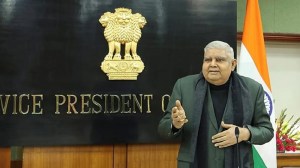‘College kahan hai?’ Years after land allotted in Ghumanhera, villagers still wait
“It is in Chirag Dilli, more than 45 km away. It just wasn’t possible to commute every day,” he recalls. He eventually completed his degree from DU’s School of Open Learning (SOL).
 A defunct MCD school at Shikarpur village in Southwest Delhi where families house their cattle.
A defunct MCD school at Shikarpur village in Southwest Delhi where families house their cattle.Fifteen years ago, Gulshan Tyagi, who now runs a cyber cafe in Shikarpur village on the outskirts of Southwest Delhi, had enrolled in Delhi University’s Shaheed Bhagat Singh College. But he had to drop out within a year.
“It is in Chirag Dilli, more than 45 km away. It just wasn’t possible to commute every day,” he recalls. He eventually completed his degree from DU’s School of Open Learning (SOL).
Tyagi, who is now 38, observes that not much has changed since then. His cyber cafe is frequented by a large number of local students, who, according to him, opt to register for open and distance learning courses instead of choosing regular colleges. The reason is the same. Most colleges are far away.
“After Class 12, most students don’t even think about regular college. They just start working and take admission in Indira Gandhi National Open University (IGNOU),” he shares.
In 2018, a government proposal to establish a college on 16.5 acres of gram sabha land in neighbouring Ghumanhera village ignited a spark of hope among residents of Shikarpur, Jhatikara, Jhuljhuli, among other villages. Seven years later, that land still lies vacant.
 The 16 acre-site earmarked for college or university to be built in Ghumanhera village
The 16 acre-site earmarked for college or university to be built in Ghumanhera village
Earlier this month, Public Works Department (PWD) Minister Parvesh Sahib Singh announced the construction of an Om-shaped Municipal Corporation of Delhi (MCD) school in Ghumanhera and a cow shelter, estimated to cost Rs 47 crore.
The cowshed is pitched to be Delhi’s largest government-run facility of its kind. It is set to come up near the site earmarked for the college.
At the groundbreaking ceremony on May 18, the PWD Minister said the new MCD school, to be built at the cost of Rs 6 crore, would have six smart classrooms, among other facilities.
But residents remain unconvinced. “College kaha hai… college toh hai hi nahi (Where is the college? There is none),” says Manoj Singh Yadav, a resident of Ghumanhera. “Our children are going as far as Dwarka, and Rajouri Garden, and even to colleges in Haryana. Some just quit studies after school.”
“Who are these new schools for?” asks Tyagi, who is also a member of the managing committee of a senior secondary government school in Shikarpur. “There are already four government schools in Ghumanhera, including two MCD schools. The children of daily-wage workers study here, but the attendance is low,” he says.
 The 16 acre-site earmarked for college or university to be built in Ghumanhera village
The 16 acre-site earmarked for college or university to be built in Ghumanhera village
A government boys’ senior secondary school in Ghumanhera has 140 students enrolled. The girls’ Sarvodaya Vidyalaya has 504. In Jhatikra, the government built a new building for just 160 school students, adds Tyagi.
A close look at the school infrastructure in the surrounding area shows a similar pattern. From Sarangpur to Hasanpur, Malikpur to Rawta, schools are scattered across villages with inconsistent enrolments, limited secondary school options, and no college campus in sight.
In Shikarpur, a defunct MCD girls’ school is now used by two to three village families to house cattle. “There’s no need to build more buildings,” says Tyagi.
Gulab Singh, former Aam Aadmi Party (AAP) MLA from Matiala, the Assembly constituency where the village is located, points out that “the land for the college is already available and belongs to the gram sabha”. “I coordinated with various departments for five to six years, worked on layouts, enrolment projections, even discussed transportation,” he says, and adds, “PWD prepared a layout plan. The only thing left was to transfer land from DDA to the Revenue Department. Then suddenly, the government announced a cow shelter and another school.”
Earlier this month, Centre for Youth Culture Law and Environment (CYCLE), a nonprofit, issued a legal notice to the Delhi government, citing contempt of Supreme Court and Delhi High Court orders that protect gram sabha lands from being diverted without public consultation. The nonprofit claimed that the new projects – the cow shed and the MCD school — did not align with the requirements of residents.
“How can we expect students, and especially girls, to go far away from these facilities that are the only way forward for them to secure a future,” says Paras Tyagi, co-founder of CYCLE.
A project site map showed that the proposed college site in Ghumanhera, roughly 90 bighas and 18 biswas, is surrounded by more than a dozen villages within a 3–4 km radius: Jhatikara, Shikarpur, Jhuljhuli, Sarangpur, Rawta, Malikpur, Dariyapur Khurd, Hasanpur, Pandawala Khurd, Daulatpur, and Sherpur. The nearest government college, Bhagini Nivedita, is eight kilometres away.
An internal report by Dr. B.R. Ambedkar University Delhi, seen by The Indian Express, gave details of the joint inspection of the Ghumanhera site in 2018. Citing an interaction with locals, it underlined,
“The villagers pleaded that there are no educational institutions within a 15 km radius of the proposed site and the students passing out of the nearby schools have to travel 20–25 km to the nearest colleges of Delhi University. Villagers were interested in an institution of higher education offering courses in humanities, and social sciences, and not in technical education.”
The report described the site as “a wasteland… only entry available presently is a 150–200 metres walk on 10 feet wide pagdandi (narrow footpath).”
“Admissions in any college or university are done on the basis of merit or entrance examination, and therefore, there is no assurance for local students to get admission in the proposed college or university,” the report underlined.
The Indian Express reached out to Dr. B.R. Ambedkar University Delhi (AUD), the Public Works Department (PWD), for comments, but did not receive any response. MLA Sandeep Sehrawat said he will gather details of the matter.
Meahwile, according to AAP’s Singh, when the site was first identified, he raised the matter in the Delhi Assembly and sought priority for locals. “If a college comes up, then 85% of the reservation should be for our children,” he insisted.
Ram Kishan, 86, a resident, says the government is wasting what could be a transformative opportunity. “The biggest hurdle is the lack of access road to the site land. Had measures been taken to build a connecting road, would the project remain stalled?” he asks.
Moreover, Ghumanhera was once known for its hockey players. “It was a big thing when we managed to get a turf ground placed here,” recalls Tyagi. “But now, a large part of the youth is getting pulled into criminal activities. The COBRA gang that operates in this belt also has roots in this village. If a higher education institute is built here, it will change how our youth see themselves and their future.”
According to Singh, “it was a dream to build the hockey turf” in the village. “We achieved that. But the bigger dream was to set up a college. That would have changed lakhs of lives in all the villages and colonies nearby,” he says.












